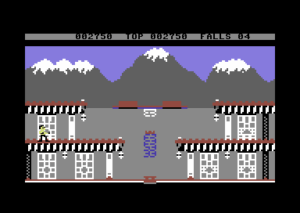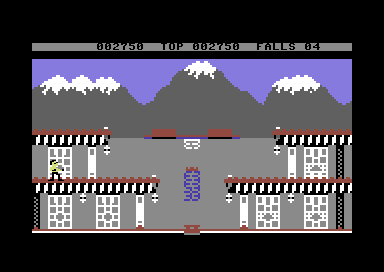
Bruce Lee, released in 1984 by Datasoft, is remembered as one of the most iconic action platformers of its time. Players take on the role of martial arts legend Bruce Lee, navigating a series of trap-filled rooms while battling enemies such as the black ninja and the green sumo wrestler. The goal is to collect lanterns scattered throughout each screen, which unlock the way forward. What set the game apart was its blend of fast-paced combat, clever platforming, and the ability to play cooperatively or competitively with a second player controlling the sumo wrestler. For C64 owners in the 80s, it was a standout title that combined simplicity with addictive gameplay.
Visually, Bruce Lee pushed the C64’s limits with colorful, varied environments ranging from gardens and dungeons to electric-filled chambers. The game’s charm lay in its balance: easy to learn but difficult to master, with enemies that kept players on their toes. It was also notable for being accessible—fun for casual players yet rewarding for those who mastered its patterns. Even today, Bruce Lee remains a cult classic, often praised in retro-gaming circles as one of the best examples of early action-platform gaming on home computers. Its influence can still be felt in modern indie titles that draw on its mix of martial arts, exploration, and cooperative chaos.
Here are four fun facts about Bruce Lee on the Commodore 64 that fans still love to share:
-
Two-player twist – While most people remember Bruce as a solo adventure, the game actually had a quirky two-player mode. A second player could control the green sumo wrestler, which meant instead of helping Bruce, you’d often end up chasing him around the screen in pure chaos.
-
Endless enemies – The black ninja and green sumo weren’t just set characters—they endlessly respawned! No matter how many times you knocked them out, they’d be back in seconds, keeping you on edge and making it impossible to truly “clear” a room.
-
Cross-platform legacy – Though many remember it as a C64 classic, Bruce Lee also made its way to other systems like the Atari 8-bit and ZX Spectrum. Still, the Commodore 64 version is often considered the smoothest and most polished, and it’s the one that became most associated with the game’s legacy.
- Game Looping – Upon completing the game, it “loops” again. From the second loop on, the Ninja and Yamo are replaced as soon as they are killed, and the safe spots in the room with multiple electrified combs are removed. I definitely was not aware of this as I’ve never finished the game!
Check out the gameplay from the game below:

Cheats
Like a lot of old-school C64 titles, Bruce Lee had a few cheats and trainer versions floating around! Back in the day, many people discovered them through magazine tips or “cracked” copies with cheat menus. Here are the main ones remembered:
-
Infinite Lives (Trainer versions): Many cracked releases of Bruce Lee came with an option to turn on unlimited lives right at the start screen. This was the most common cheat because the game could be brutal once you reached the electric traps.
-
Pause & Invulnerability Trick (some versions): On certain cracked or modified versions, hitting the Run/Stop key would freeze the game, and if combined with certain key presses (like RESTORE), it could toggle invulnerability. This wasn’t in the original retail release but was a common hack.
-
Level Skips (hacked versions): Some later tape/disk releases offered “Poke” codes you could type in before running the game to start at later levels or skip directly to the finale. These were shared in C64 magazines and user clubs rather than being official features.
-
- Infinite Lives
-
- POKE 2325,165
POKE 2326,165
- POKE 2325,165
-
- Start with 255 Lives
-
- POKE 5277,173
-
- Stop Energy Drain
-
- POKE 5407,173
-
- Infinite Lives
-
Out of the box, the original Datasoft release didn’t include built-in cheats—it was meant to be tough and replayable. Most of the cheats we remember came from cracked versions passed around on floppy disks in the playground.




